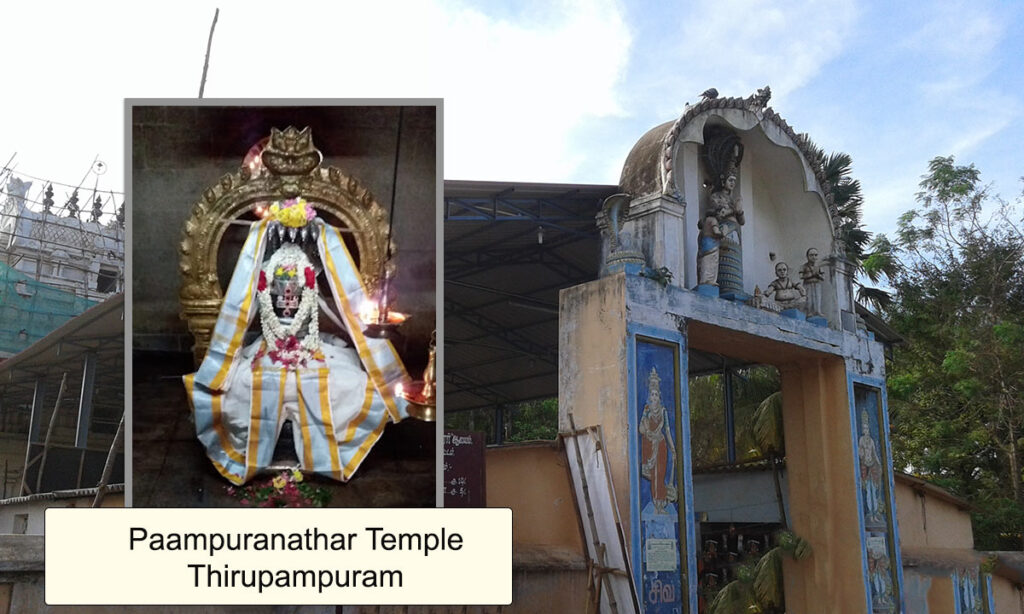The first time I heard about Thirupampuram Temple, it wasn’t from a guidebook. A neighbor, after finishing a pilgrimage, told me in hushed tones that this temple was where people found relief from Rahu-Ketu dosham. Curiosity mixed with devotion, and I knew I had to see it for myself.
When I finally stepped into the village, tucked between Kumbakonam and Mayiladuthurai, the place felt like time had slowed down. Narrow roads, tiny tea stalls, and the faint smell of incense guided me to the temple gates.

How to Reach There (Travel Distances)
If you’re like me and worry more about the “how do I reach?” than the “why should I go?”, let me break it down:
- Kumbakonam to Thirupampuram Temple distance: About 25 km. A short drive, though buses run regularly too.
- Mayiladuthurai to Thirupampuram Temple distance: Roughly 20 km. The bus ride from here is slower but more scenic – paddy fields, coconut groves, and quiet villages waving you along.
- Thirupampuram temple bus route: Plenty of local buses connect both towns to the temple. I almost missed mine at Mayiladuthurai bus stand, but locals are kind and will point you in the right direction.
If you’re driving, Google Maps shows the Thirupampuram temple location clearly. But don’t be surprised if a passing villager suggests a shorter route – their shortcuts usually work!
Planning Your Visit? Check the Temple Timings
I learned the hard way that you can’t just walk into a South Indian temple at any hour. The priest gently told me, “Son, the deities rest too.” That’s when I checked the Thirupampuram temple timings:
- Morning: 7:00 AM – 12:00 PM
- Evening: 4:00 PM – 8:00 PM
For those planning special rituals, there are Thirupampuram temple pariharam timings as well. Pilgrims often arrive early to perform Rahu-Ketu pariharam, believing it helps remove obstacles in marriage and career.
If you’re searching online, you’ll also find Thirupampuram temple timings in Tamil, which is helpful for locals and devotees traveling from nearby towns.
The Feel Inside the Temple
The temple isn’t massive like Chidambaram or Madurai, but it carries an aura that feels… personal. The deity here is Karkodaga Maharishi, and the stories say even the serpent saints worshipped here. The shrines for Rahu and Ketu draw the longest lines, as families wait patiently for their turn to offer prayers.
I noticed something interesting – unlike in many crowded temples, people here didn’t push or rush. Everyone stood quietly, murmuring prayers, some even with closed eyes, as though they were in conversation with the gods.
Online Booking to Avoid Standing in Queue
A fellow devotee whispered to me that nowadays, some services allow Thirupampuram temple online booking for pujas. Honestly, I didn’t try it – part of me liked the old-school way of standing in line, talking to the priest, and offering coconuts by hand. But if you’re traveling with elderly family members, checking the online option might save time.
Travel Notes
- Footwear: Leave them outside the gate. A local boy offered to watch mine for ₹10.
- Food: Don’t expect fancy restaurants nearby. I grabbed a plate of idlis from a small thatched eatery, and honestly, they tasted better than anything in the city.
- Language: If you don’t know Tamil, don’t panic. Most people around temples understand enough English or Hindi to guide you.
- Vibe: It’s quiet. Very quiet. If you’re used to the buzz of city life, the calm here might feel strange at first… but give it ten minutes, and you’ll start to like it.
Why Thirupampuram Temple Visit is Memorable?
As I walked out after the evening pooja, the sun had already dipped, and lamps flickered across the temple walls. The bus back to Kumbakonam took almost an hour that night, but I didn’t mind. My mind kept replaying the image of devotees bowing at Rahu and Ketu shrines.
The Thirupampuram Temple isn’t about grand architecture or tourist clicks. It’s about faith, quiet rituals, and the belief that sometimes the stars in our lives can be nudged back into place with prayer.
And maybe that’s why people keep coming here, generation after generation.
Want travel assistance?
Plan your Thirupampuram Temple trip with DiyaTemplesTour today – hassle-free, affordable, and perfectly timed for an unforgettable visit!
Frequently Asked Questions (FAQ’s)
1) What is Thirupampuram Temple famous for?
Thirupampuram Temple is well-known for performing Rahu–Ketu dosha pariharam. Devotees believe that worshipping here helps overcome obstacles related to marriage, career delays, and family well-being.
2) How do I reach Thirupampuram Temple from Kumbakonam?
The temple is around 25 km from Kumbakonam. You can hire a taxi, drive by car, or take a local bus. The ride takes about 40 minutes.
3) How far is Thirupampuram Temple from Mayiladuthurai?
It is about 20 km from Mayiladuthurai, with frequent buses and shared autos available. The journey is scenic and takes roughly 30–35 minutes.
4) What are the Thirupampuram Temple timings?
The temple usually remains open from 7:00 AM to 12:00 PM and again from 4:00 PM to 8:00 PM. For Rahu-Ketu pariharam timings, mornings are considered most auspicious.
5) Is online booking available for pujas at Thirupampuram Temple?
Yes, some platforms offer online booking for special pujas and sevas. However, many pilgrims still prefer booking directly at the temple counter.
6) Which bus route goes to Thirupampuram Temple?
Regular buses from Kumbakonam and Mayiladuthurai stop at nearby points, and from there, it’s a short walk or auto ride to the temple.
7) What is the best time to visit Thirupampuram Temple?
Devotees often visit during Rahu Kalam and auspicious festival days. If you prefer less crowd, weekdays in the early morning are ideal.

